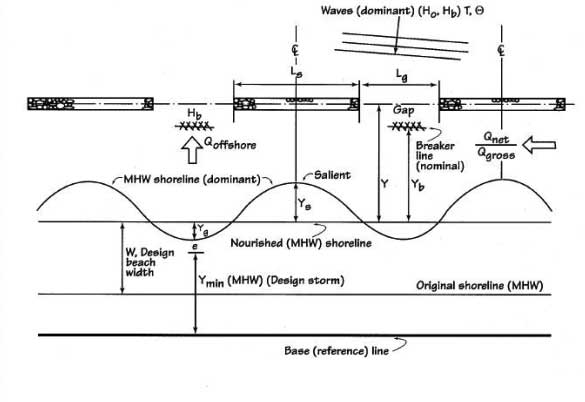Wayfarer reef design is a complex and environmentally interactive process. The final project cost will be determined by the balancing of a number of physical, fiscal, environmental, regulatory and asthetic goals. One of the more complex criteria encountered in designing a shoreline protection project are the engineered gaps. There are different types of gaps which may optionally be used with a shoreline protection project.
Segment Gaps
 A segment gap is a gap between two segments of Wayfarer's semi-artificial reef in the same project / deployment. The width of each gap and the length of each segment (the gap interval) are determined by classic coastal engineering analysis. The relationship between segment length (segment gap interval), segment gap length, and distance to shore affect the wave - shoreline interaction. The accompanying diagram from the Coastal Engineering Manual is intended to help visually illustrate the segment gap principles and relationships. The Wayfarer project estimate calculator segment gap length is represented in the diagram as 'Lg'. The estimate calculator segment gap interval length is represented in the diagram as 'Ls'. You may include or ignore these parameters in the calculator.
A segment gap is a gap between two segments of Wayfarer's semi-artificial reef in the same project / deployment. The width of each gap and the length of each segment (the gap interval) are determined by classic coastal engineering analysis. The relationship between segment length (segment gap interval), segment gap length, and distance to shore affect the wave - shoreline interaction. The accompanying diagram from the Coastal Engineering Manual is intended to help visually illustrate the segment gap principles and relationships. The Wayfarer project estimate calculator segment gap length is represented in the diagram as 'Lg'. The estimate calculator segment gap interval length is represented in the diagram as 'Ls'. You may include or ignore these parameters in the calculator.
Spacing Gaps
As a design element and/or in response to fiscal constraints it is possible to fully implement your shoreline protection project using fewer units by introducing spacing gaps between individual units. Spacing gaps may reduce the number of oyster reef units needed by as much as 10% to 20% compared to units with no spacing gap. Part of the engineering for each project will be a determination of whether unit spacing gaps are acceptable and if so how large they might be.
Top Gaps
As a design element and/or in response to fiscal constraints it may be possible to consider leaving out a small percentage of oyster reef units in the top layer of a multi-layer reef structure. Basically fewer oyster reef units used in the overall project correlate directly to a lower reef project cost. However, these top gaps will have an impact on other project goals. So, oyster reef top gaps may only be considered after a careful and thorough project design based on your environmental, asthetic, and protection goals.
When using our Wayfarer Shoreline Protection project estimate calculator you may specify flushing gap parameters. We will be happy to discuss oyster reef top layer gaps based on your overall project needs.
